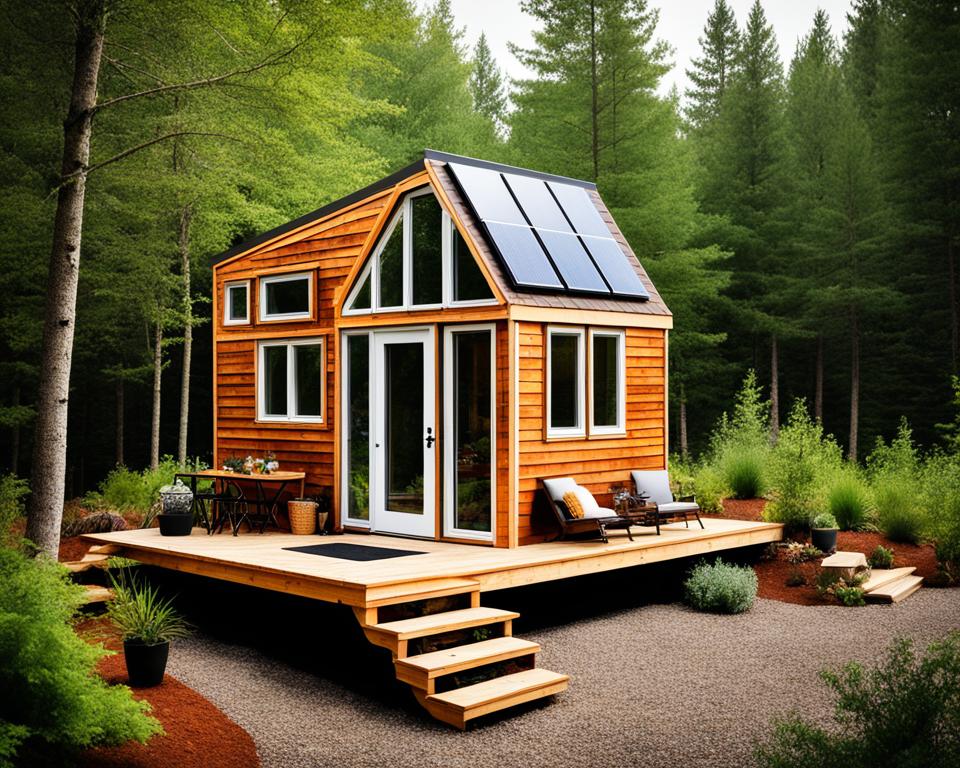Did you know the average American home spans nearly 2,600 square feet? A tiny house, however, rarely oversteps 400 square feet. This fact hasn’t stopped many from choosing to downsize for a sustainable lifestyle. With less space to oversee and a reduced environmental footprint, the appeal of tiny living shines. If the idea of a tiny house intrigues you, you’re in good company. We’ll delve into actionable tips for tiny house living. Plus, we’ll see how adopting a minimalist lifestyle can enrich both our lives and the planet.
Tiny homes signify more than just a smaller living area; they represent a deliberate move towards minimal consumption and enhanced life quality. Your drive might be financial freedom or a passion for the environment. Regardless, the journey to a tiny home is full of purpose and creativity. Along this road, we find not just a dwelling, but also a community. It embodies a new standard of success, marked by fewer square feet yet richer experiences.
Funding Your Tiny House Dream
Moving to a tiny home means starting an exciting financial journey. Tiny house dreams and budgets are not the same for everyone. Choosing a minimalist lifestyle in a tiny house means more than just living in a smaller space. It’s about living affordably. This starts with careful budget planning and smart money decisions.
Calculating the Costs: Budgeting for Tiny Living
Setting up the right budget is key to tiny living success. We must first understand all the costs involved. Tiny houses vary in price. This depends on things like materials, work needed, and where it’s built. We have to make a detailed budget. This includes construction and other costs like insurance, utilities, and upkeep. These help us keep living tiny and minimal.
Navigating Loans and Mortgages for Smaller Dwellings
Big bank mortgages might not always work for tiny houses. But, there are new loan types coming out for them. More and more, lenders see tiny houses as something they can finance. We will look into the best loans for downsizing. This might mean finding a personal loan with good terms or a special mortgage for tiny, sustainable houses.
Exploring Alternative Financing: Personal Loans and Community Support
But we’re not just stuck with standard finance options. The tiny house world is full of ways to get support from others. Through personal loans, crowd funding, or joining finances with other tiny house fans, we can find affordable funding. Together, we might create new ways to pay for our homes. Maybe we’ll even start an eco-village that fits our dream of affordable tiny house living.
Understanding Zoning and Legal Requirements
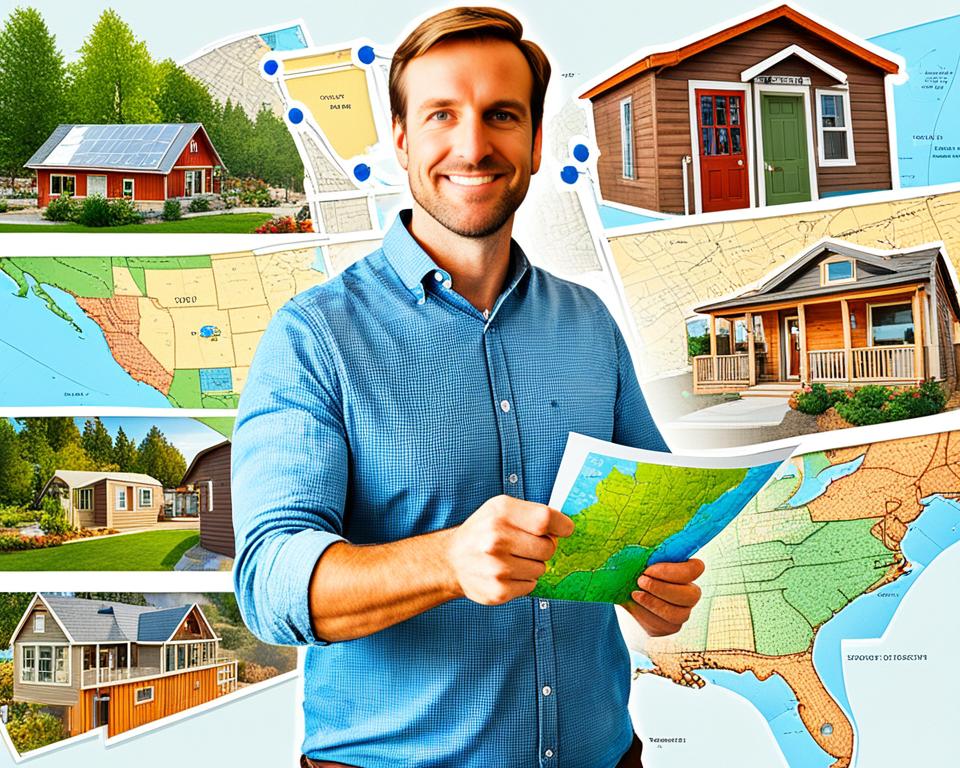
Thinking about optimizing small living spaces means more than just arranging our spaces wisely. It also means knowing the legal rules for building tiny homes. This is crucial because zoning laws can be different depending on the location.
To help, we’ll go over some zoning categories related to tiny houses:
| Zoning Category | Description | Considerations for Tiny Houses |
|---|---|---|
| Residential | Areas designated for living purposes | Check minimum square footage requirements |
| Commercial | Areas allocated for business activities | Opportunity for dual-use properties |
| Agricultural | Lands intended for farming or ranching | Potential for more lenient building codes |
| Mobile Home Parks | Designated areas for mobile homes | May accommodate tiny houses on wheels |
Often tiny homes don’t fit neatly into zoning rules. A key tip is to talk with local zoning boards and planners. They can help clarify if your tiny house could be seen as ‘modular’, ‘mobile’, or ‘compact’.
Thinking outside the box is crucial. For example, using your land for a small campsite could fit better with commercial zoning. This strategy might make it easier to have tiny homes legally.
Knowing the specific rules about size, height, and use of utilities is vital. Zoning laws weren’t made with tiny homes in mind. This means we need to be creative and proactive to live in tiny homes legally.
Get to know these laws, seek advice from experts, and join groups that support tiny house living. By working together, we can help change the laws to recognize and embrace tiny homes. This push supports more sustainable and affordable living options.
How to Start Living in a Tiny House: A Step-by-Step Guide
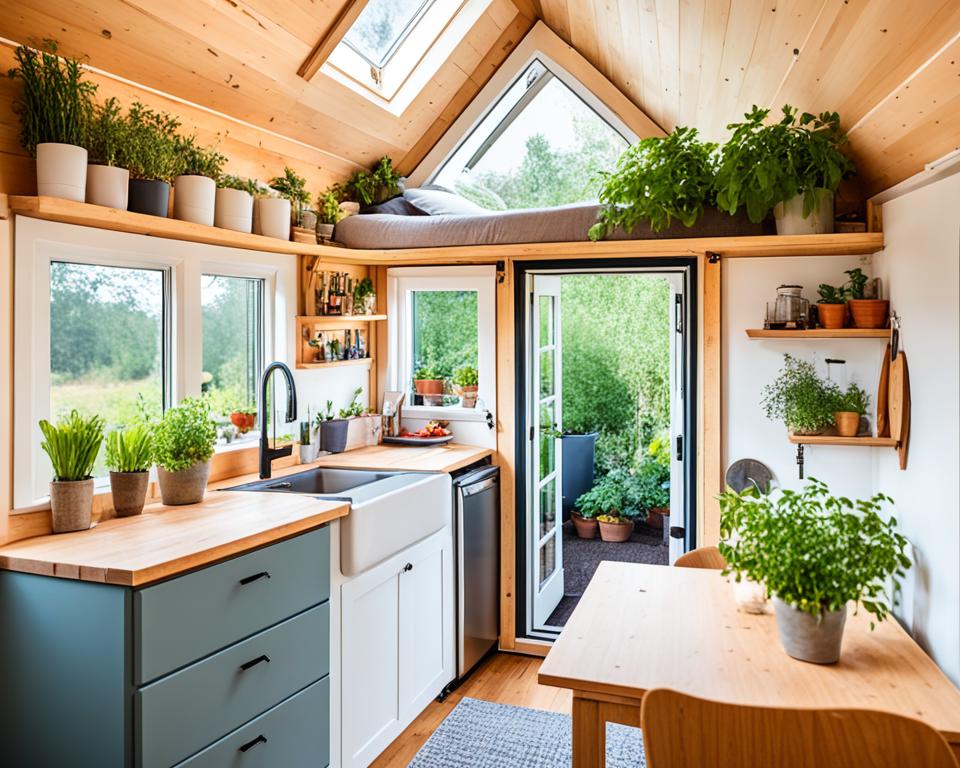
Welcome to the start of your tiny house adventure! Making smart choices is key for a happy tiny home life. Following some important steps will help you live sustainably in a small space. This makes sure your tiny home life is rewarding and fun.
Selecting the Right Tiny House for Your Lifestyle
First, decide which tiny house suits your lifestyle. Ask yourself if you want to move around or stay in one spot. This choice affects if you should have a tiny house on wheels or a fixed foundation. Think about size, materials, and design. Also, consider if you want to build new or buy used for a comfy tiny home life.
Downsizing Possessions for a Simplified Life
Living with less means getting rid of things you don’t need. In a tiny house, everything must have a purpose. Start by looking at what you own and keep only valuable things. Being strict but thoughtful is key. This not only cuts down clutter but also helps us let go of stuff. It teaches us the beauty in having just what we need.
Getting Acquainted with Tiny House Utilities and Off-Grid Options
Next, learn about your tiny home’s utilities for a green life. Explore how to get water, manage waste, and use renewable energy like solar panels. If off-grid living interests you, learn about rainwater collection, composting toilets, and solar power. Living off the grid can be very rewarding and brings you closer to nature.
Moving into a tiny house is a big move to innovative living. We’ll share tips to help make your minimalist lifestyle transition smooth. Let’s turn your tiny house dream into reality, one step at a time!
Maximizing Space: Design and Organization Hacks for Tiny House Living
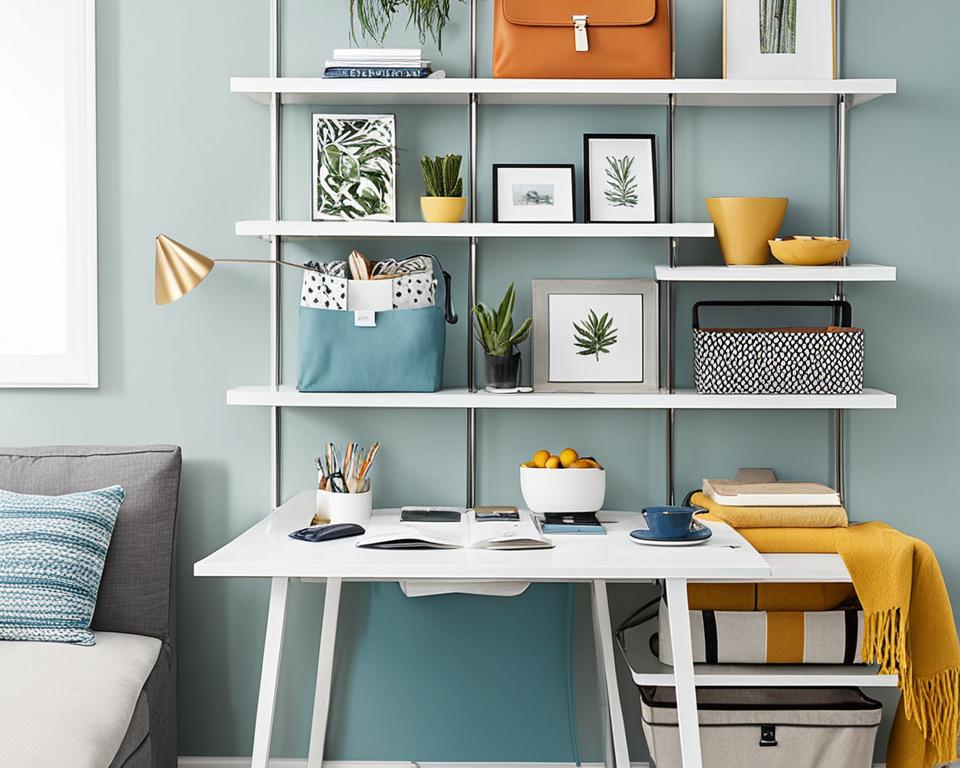
Shifting to downsizing to a tiny home teaches us the value of space. Every inch counts, requiring smart planning and organization. Here are some top hacks to make your tiny house both functional and a paradise.
Multipurpose furniture is a game changer. Think of a couch with storage, a foldable dining table, and beds with drawers. This way, everything in your home does more than one job. It’s all about saving space.
Getting creative with storage is key. Use the space up high with lofted shelves. This move frees up the floor and keeps things within reach. Going high can mean hanging kitchen items or shelves over doors.
Vertical gardens turn a wall into a living art piece. They are both a food source and a living area highlight.
Don’t overlook hidden spots in your tiny home. Stairs with drawers or floors with secret compartments keep your place looking sleek. You don’t have to give up on keeping things you love.
For home workers, fold-down desks are perfect. They fold back into the wall when you’re done, clearing up space. It’s great for switching between work and leisure.
Our Checklist for Tiny Home Efficiency:
- Multi-use furniture like sleeper sofas with storage
- Built-in storage spaces including under-floor compartments
- Lofted spaces for sleeping or storage to maximize floor area
- Wall-mounted folding tables for work or dining
- Stackable and collapsible items that can be tucked away
Use these tips to downsize to a tiny home comfortably and in style. Tailor your tiny house to fit your life. With these hacks, our tiny homes become smart, space-efficient, and great to live in.
Embracing the Tiny House Lifestyle: From Concept to Reality
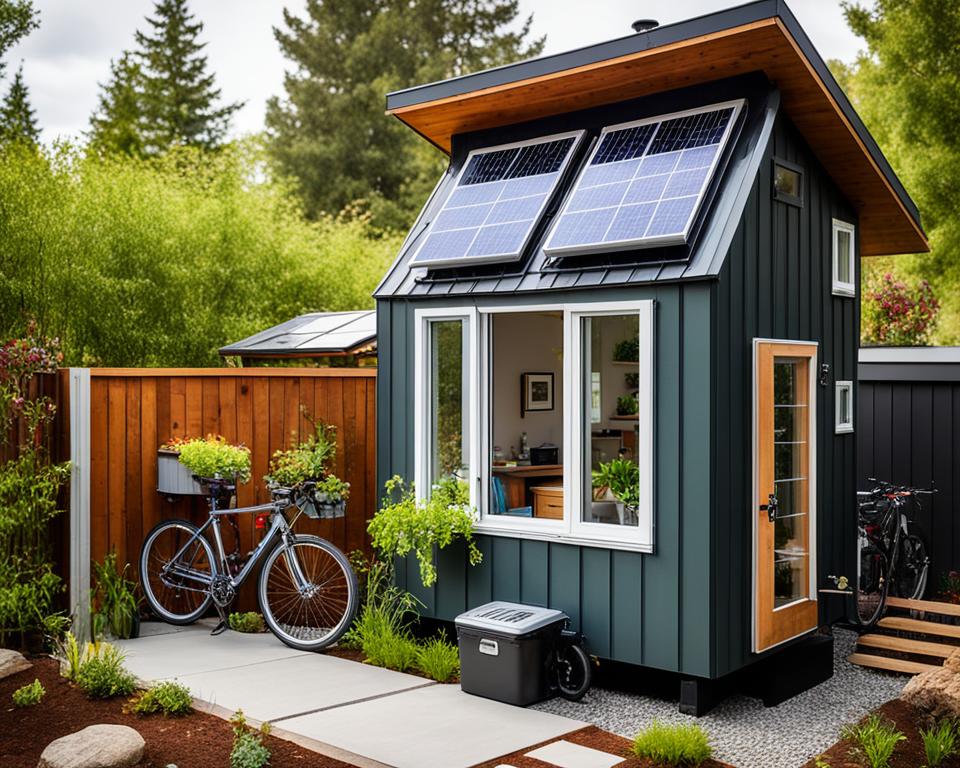
When we dive into sustainable living in a small space, we see it’s more than cutting down on space. It’s about changing what we value and what we prioritize. The benefits of tiny house living touch not just our finances but also our planet in big, positive ways. How do we move from big homes to this green way of living? Let’s find out.
First, it requires deliberate choices. Ask yourself what items are truly important? How can we live more sustainably every day? It’s not solely about owning fewer things. It’s about valuing everything we choose to keep. Everything in our tiny home must have a purpose or bring happiness.
Next, living tiny makes us rethink our needs. With a smaller home, our environmental footprint shrinks significantly. We use less, waste less, and thus, impact the Earth less harshly. A small home encourages a big, experience-rich life over one filled with stuff.
“The tiny house movement encapsulates the essence of living mindfully and looking past material possessions to find true happiness.”
| Benefits of Tiny House Living | Traditional Home Living |
|---|---|
| Lower living expenses | Higher costs due to more space and maintenance |
| Reduced environmental impact | Larger carbon footprint due to size and energy needs |
| Intentional living with less clutter | More space often leads to more unnecessary possessions |
| Community and simplicity | Oftentimes isolated and complex in nature |
Embracing change is key. The freedom and flexibility in sustainable living in a small space need an open, adaptable mindset. Tiny home dwellers share strong bonds, based on common values and experiences. By choosing to live intentionally, with the benefits of tiny house living, we create homes that showcase our dedication to a simple, sustainable life.
In short, the tiny house lifestyle is more than just choosing a small home. It’s about shaping a meaningful life with community and sustainability at its core. A tiny house symbolizes our choice in how we live our lives on this planet.
The Social Dynamics of Tiny Living: Community and Relationships
When we choose tiny living, we change more than just our homes. We change how we connect with others. This lifestyle makes us rethink our social ties, focusing on community and close relationships. By living close, we bond more with our neighbors who share our lifestyle.
Tiny living teaches us to rely on each other, from borrowing tools to building together. This creates a strong sense of solidarity. We celebrate each other’s success and happiness. It’s all about supporting one another.
Tiny houses make us get creative with how we hang out with friends. We can’t have big parties, so we find new, fun ways to gather. We enjoy potlucks in community gardens and movie nights outside. These unique moments bring us closer together, proving it’s the people, not the space, that matter.
Let’s remember to value the connections we can build in tiny living. Whether online or in person, this lifestyle shows us the power of less. Choosing to live tiny is choosing a shared journey. It leads to a community that values support, joy, and connections.
In our tiny house world, we find more than just eco-friendly homes. We discover a wide, connected community. Our small homes are gateways to big, shared lives. They show us the beauty of living together in simplicity.

